 |
surfresearch.com.au
a history of surf knowledge |
| home | catalogue | history | references | appendix |
|
surf-riding
culture, surf knowledge - n. the total accumulation of the ways and
methods of surf-riding built up by surfriders, and transmitted from one
generation to another. (Macquarie Dictionary, 1991, Adapted.)
15,000
Out of the Trees : Mankinds'
first encounters with Water.
Of course any consideration of mankind's
earliest ecounters with substantial bodies of water is purely speculative,
but in 1997 Morgan suggested that the development of mankinds' vertical
stance and gait was enhanced by transversing large bodies of water,
resulting from the climate change that induced the intial rejection of
tree dwelling. This has been labelled 'The Aquatic Theory'.
"It is possible that our early
ancestors began their adaptation to bipedalism with initial wading behaviour,
just as we see the modern macaques, probosis and capuchins doing.
As it foraged for aquatic vegetation,
and perhaps small crustaceans and mollusks, the little primate would soon
discover it could wade deeper on two legs than four, thus expanding and
exploiting available resources for food (Morgan 1997).
This behaviour could have far-reaching
consequences."
Catherine Friedl : Why
Bipedalism? Good Reasons to Wade and Remain Near Water. March
2000
http://hoopermuseum.earthsci.carleton.ca//aquatic/wat8.htm
If this theory has any validity, then humans
developed an imtimate awareness of the pleasures and the dangers of water
from their earliest times.
It would be readily observed that the
larger the body of water, then the greater the potential resources and
the greater the potential danger.
The Aquatic scenario may also relect upon
possible tool use - a walking stick would indicate water depth and identify
obstructions.
In difficult transitions, a stick could
assist members to link in an extended chain
.
At an extreme, observing small animals stranded on floating logs could
have suggested similar possibilities for humans.
65,000 B.C.E.
Out of Africa - A Maritime
Migration
Modern humans who left East Africa
more than 65,000 years ago and eventually populated the globe were beach-combers
who headed south first, moving around the shores of the Indian Ocean at
up to
four kilometres a year, new genetic
research of indigenous people in South-East Asia
suggests.
"It's much easier to move quickly
along a coast," said the Australian National University's David Bulbeck,
a member of an international research team that studied people in the Malaysian
peninsula.
Seafood would have been plentiful,
and the travellers would have had to adapt to only one
environment, rather than learn how
to survive in the deserts, rainforests and shrublands of an
overland route.
Debora Smith (Science Editor) : Earth's
first beachcombers ended up in Australia.
Sydney Morning Herald : Weekend
Edition, May 14-15 2005 News : Page 13.
Reporting research developments published
in Science Magazine, 13 May 2005.
Forster and Matsumura : EVOLUTION
: Enhanced: Did Early Humans Go North or South?
Science Magazine, 2005, Number308
Pages : 965-966
This would indicate that from circa 65,000
B.C.E. mankind was intiating the parameters of a maritime culture.
The basic elements would be safety, weather
prediction, harvesting food, recreation and transport.
The ever present danger of drowning would
primary in the concerns of a maritime culture.
In life threating situations, one rule
would become prominant - "Don't Panic".
Furthermore, there may have been a growing
awareness
of the possibility of rescue, possibly in conjunction with some preceived
social obligation to assist those in distress.
In subsequent history, considerable activity
will be directed to the development of efficient surf rescue technics and
services.
The ability to predict weather
conditions is a significant determinant in successful harvesting and navigation.
IIt enhanced safety by avoiding turbulent
water events, and enhanced pleasure by attendence at sublime water events.
In the 21st century, surf prediction has
become a highly technologically advanced science.
By confining occupation to a marine environment, food was harvested from a consistant source and employed a common inventory of tools and methods.
Recreation in a maritime enviroment is
determined by the prevailing weather conditions.
Prime allocation must be given to suitable
harvesting conditions, and the remaining leisure time is itself weather
dependent.
High surf conditions can often limit coastal
harvesting activities
The first use of water for transportation
was, undoubtably, by log.
65,000B.C.E.
Many rivers to cross
: The Log
Whether by observation, accumulated experiernce
or by accident; initial attempts to transverse deep or rapidly flowing
water was probably by log.
XXXXXXXX
EDIT FROM HERE ....
Either Canoes or boards.
Note that for canoes the advantages
were substantial, particually in the case of potential shark or crocodile
attack.
"Homo erectus, incidentally,
concievably made boats as well as fire; we should not underestimate them."
Dawkins, Richard: Unwearing the Rainbow
- Science, Delusion and The Appetite for Wonder
Allen Lane
The Penguin Press
Penguin Books Ltd
27 Wrights Lane , London, W8 5TZ, England.1988.
Page 296
2003 B.C. A Piece of
Wood
Recreational wave riding , either body
surfing or assisted by a small board, was practised throughout the Pacific
Islands and probably predates the Polynesian migration from Asia, which
began aroudnd 2000 B.C.
Their navigation skills took them
to the Solomon Islands, around 1600 BC, and later to Fiji and Tonga.
By the beginning of the 1st millennium
BC, most of Polynesia was a loose web of thriving cultures who settled
on the islands' coasts and lived off the sea.
By 500 BC Micronesia was completely
colonized.
Initial migration by small groups across
small distances in crude craft.
Travell would be directed at observable
land masses, that is approximately 5 kilometres.
Craft could vary from a simple single
log to a timber raft.
As distances between islands became longer,
larger rafts would be required to carry larger numbers of passengers and
or supplies.
On occassion rafts could possibly be wind
driven by a simple square sail.
The development from this crude base to
sophisticated sailing canoes was concurrent with the use of a simple board
for personal transport over short distances.
The use of a small paddleboard was
to have two significant impacts on Polynesian culture....
1. It was adapted as a tool of recreation (exhilaration?) with the development of surfriding.

Shooting on a board and in a canoe
must have started further back than body shooting.
... The board is worked on
the same principle (as the canoe), but its control calls for
much greater skill.
- Duke Kahanamoku, The Sun, Friday
8th January 1914.
Interview by W. F. Corbett.
At the start of the 20th century, the Polynesian
style (often mis-labeled the Australian Crawl) was becoming the
dominant competitive swimming stroke.
It was emphatically demonstrated by Duke
Kahanamoku's 1908 Stockholm Olympic performance.
By the end of the 20th century surfing had spread to across the world's oceans (and Lakes!) and surfing culture had global significance
Whatever it's primitive origins, by 400
A.D. when the first settlers reached Hawaii, five principles had been firmly
established...
1. wave riding is fun - the thrill of
the ride in is greater than the effort of the paddle out.
2. wave riding can be dangerous
3. the surfer must paddle in the same
direction as the wave to achieve take-off.
4. the ride is longer and faster if the
surfer rides diagonally across the wave face.
5. a rigid board will improve planning
and paddling - but can also increase the danger factor.

The origin of these boards is speculative, but broken sections from discarded canoes, outrigger floats or paddles (the blades) are possible sources.
| Image right :
Hawaiian paddles, circa 1800. Bishop Museum Collection. Holmes (1993) page 59. The paddles (hoe) held by the Bishop
Museum have an average blade (laulau) length of 23 inches
and a width of 12 inches.
Note that the paddles were shaped from
on piece of timber and a broken shaft would render the paddle unusable.
See Holmes Chapter 7 : Paddles. |
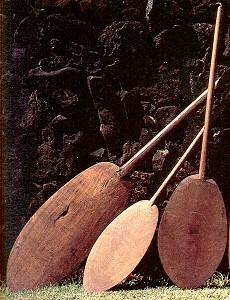 |
With the development of an adult surfing
culture, prone boards became essential in acquiring basic surf skills.
In the 20th century, the Paipo has been re-invented several times
...
- the Surf-o-plane,
- the
Bellyboard,
- the Kneeboard,
- the Spoon,
- the Coolite
- the Mat,
and the most successful (in sales, performance and safety) Tom Morey's
Booggie
Board, 1971.
Further principles were established...
6. Width is limited to the width of the
ridder's shoulders.
8. The longer the board, the greater the
paddling speed.
9. The lighter the board the greater the
floatation
10. The nose is rounded and turned up
- for cutting and take off
11. The tail is wide and square.-
for maximum planning area and maximum safety.
12. Don't let go of the board.

Dimensions vary between 6 feet and 12 feet in length, average 18 inches in width, and between half an inch and an inch and a half thick. The nose is round and turned up, the tail square. The deck and the bottom are convex, tapering to thin rounded rails. This cross-section would maintain maximum strength along the centre of the board and the rounded bottom gave directional stability, a crucial factor as the boards did not have fins.
Any discussion of the performance capabilities is largely speculation. Contemporary accounts definitely confirm that Alaia were ridden prone, kneeling and standing; and that the riders cut diagonally across the wave. Details of wave size, wave shape, stance and/or manouvres are, as would be expected, overlooked by most non-surfing observers. Most early illustrations of surfing simply fail to represent any understanding of the mechanics of wave riding. Modern surfing experience would suggest that high performance surfing is limited more by skill than equipment. It is a distinct probablity that ancient surfers rode large hollow waves deep in the curl - certainly prone, and on occassions standing.
By 1000 A.D these principles were confirmed...
13. Large waves are faster than small
waves.- a larger board is easier to achieve take off.
14. Steep waves are faster than flat waves.-
a smaller board is easier to control at take off.
15. Control is more important than speed
16. Surfboards are precious.

There are no contemporary accounts of how the boards were ridden, but it is most likely that the design was specifically for riding large swells on outside reefs, rather than on breaking or curling waves. In 1961, Tom Blake suggested that the Olo may have been ridden prone.
In the 1920's, Tom Blake and Duke Kahanamoku
reproduced the design in a hollowed version to radically reduce the
weight. See #5xx, below

Surfing's international status was boosted in October 1907 with publication in A Woman's Home Companion (of "A Royal Sport : Surfing at Waikiki" by Jack London. Jack London was a noted travel writer and the article was reprinted as a chapter in his book The Cruise of the Snark, 1911, His enthusistic instuctor was Alexander Hume Ford.
In California the exposure was more direct - George Freeth, considered one of the top riders, was commissioned to demonstate surfriding as a promotion for a land sale at Renaldo Beach in 1907. His enthusiasm and ability encouraged locals to take up the sport, and this was given further impetus with demonstations by Duke Kahanamoku in 1912, both on the West and East coasts. Duke Kahanamoku extended surfing's influence with visits to Australia and New Zealand in 1914-1915.
Surfing was limited to a very small number of native Hawaiians, but increasingly some Europeans became board riding enthusiasts. This was typified by the formation of the Outrigger Canoe Club by Alexander Hume Ford in 1908 at Waikiki. Ford enthusuiastically supported the traditional skills of surfboard riding and paddling outrigger canoes, and was Jack London's instructor.
To encourage young surfer's, entry fees were set at a minimum and boards were supplied for use or purchase ($2.00 in 1909). Developments continued with the appointment of Dad Center as Club Captain and the membership of Olympic swimmer Duke Kahanamoku in 1917.
The formation of the Outrigger Canoe
Club encouraged other surfing clubs, most noteably the Hui Nui whose members
included the Kahanamoku Brothers. Duke Kanhanmoku is credited with taking
the sport to new levels of performance and with developing the 10 ft board.
Using imported Californian redwood or sugar pine, he made thicker, wider
and longer boards to compensate for the lighter native timbers of traditional
boards. His basic design would be used around the world for the next 35
years.

This board successfully performed to Blake's expectactions, however the extreme weight was a major difficulty. His first experiment, hollowing out a solid board, had been attempted previously -
"As early as as 1918 Claude West
had experimented to make a hollow board, chippig and gouging out a solid
redwood slab and fitting a small sealed and screwed deck.
The experiment was not a success;
plywoods were not yet, nor plastic glues, timbers were sun dried intead
of kiln dried as now, and sun-cracks quickly gaped to let in water.
'Snowy' McAllister of Manly...also
experimented with chipped out boards.
He, too, was unsuccessful, though
he improved on the West model, also steamling the tail in the hope of gaining
more speed."
Maxwell
,
pages 239-240.
Probably similar attempts at hollowing
boards had been made by other surfers before Tom Blake...
however a combination of drilled holes
and extended curing made a noticable difference in weight
"This surfboard
was sixteen feet long and weight 120 pounds." Blake,
page 59
Blake also reported the length of this
board as 14 ft 6 inches in 1935, see above.
Nat Young personally interviewed Tom Blake
for his recollections of this period, published in 1983's The
History of Surfing, and although the length varies from Blake's
1935 notes, the account is detailed...
" He purchased a solid slab of redwood
16' long, 2' wide and 4" thick.
It weighed around 150 pounds - too
heavy to be of service as a surfboard, even when shaped.
So to lighten it he drilled hundreds
of holes in it from top to bottom, each hole removing a cylinder of wood
four inches long.
Then he left the holey board season
for a month.
After the wood had fully dried he
covered the top and bottom surfaces with a thin layer of wood, sealing
the holes. I
t finished up 15' long, 19" wide
and 4" thick, looking like a cigar.
It's weight was only 100 lbs, because
it was partly hollow."
Nat
History page 49
The second edition of History of Surfing (1994) is dedicated to Tom Blake who died May 5, 1994, aged 92.
The complete photograph, see below,
notes a third length for this board of 14 ft 6 inches.
There is some confusion as to these board's
actual lengths.
It is possible that the board's length
was reduced between 1926 and 1930, due to modifications or repairs - it
certainly reduced in weight..
The board's paddling performance was demonstrated in 1928 when, after a slow start, Tom Blake emphatically won the 880 yards paddling race at the Pacific Coast Surfing Contest, Balboa, California. Blake, page 59.
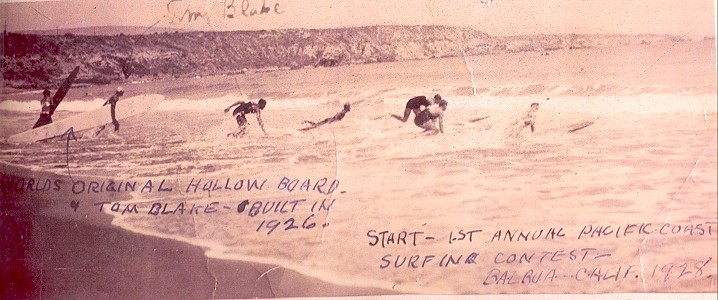
"In the later part of 1929, after
three years of experimenting, I introduced at Waikiki a new type
of surfboard;...but in reality the design was taken from the ancient Hawaiian
type of board, also from the English racing shell."
Blake,
page 51

The template of this board was radically streamlined compared to it's predecessor.
The application of a light skin over a ridgid frame for boats dates back to the Irish chonicle or the Innuit kayak.
"It was called a 'cigar board', because
a newspaper reporter thought it was shaped like a giant cigar. This board
was really graceful and beautiful to look at, and in performance so so
good that officials of the Annual surfboard Paddling Championship immediately..."
Blake,
pages 51 - 52.








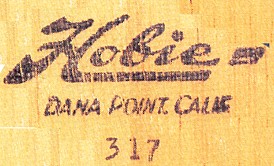


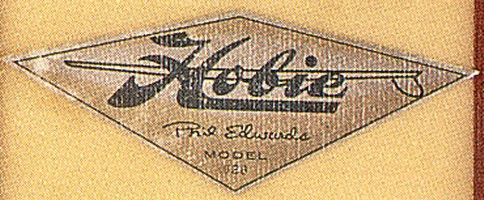

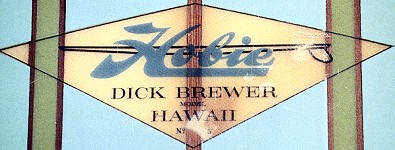








| home | catalogue | history | references | appendix |